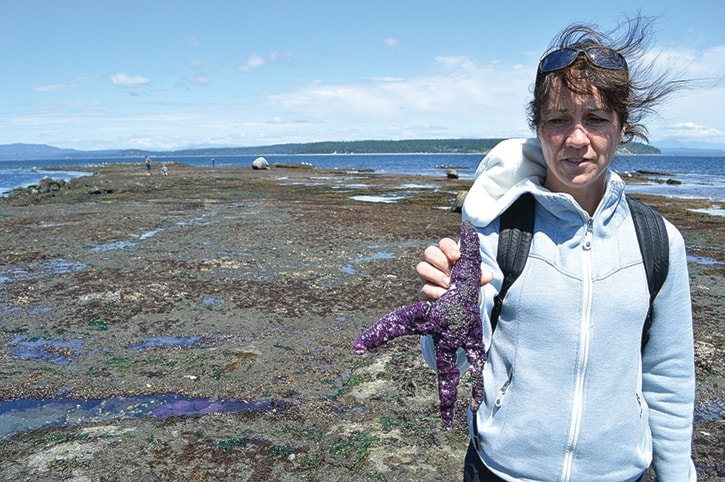“Severed arm…another severed arm, it looks like a crime scene,” says Sandra Milligan as she walks the Willow Point Reef.
After apparently avoiding the Campbell River area last year, sea star wasting syndrome is now here and local stars are disappearing at an astonishing rate.
“I walked here last month and those big rocks were loaded with purple sea stars, now there are none,” says Milligan, a biology instructor at North Island College who’s hosted intertidal walks along the reef for the past decade.
Milligan’s scrutinizing the bigger rocks closer to shore looking for surviving Pisaster, a genus of Pacific sea stars that includes three species that come in colours of ochre, brown, orange and purple.
But the rocks nearest shore are bare of Pisaster, a keystone species whose presence helps at least 10 other species of invertebrates thrive due to a delicate balance of competition.
Take away the star fish – hungry predators – and the mussel population starts to boom. That’s what Milligan sees as she walks out towards the reef: More mussels, fewer star fish and the signs of disease on the living.
Out on the reef there are numerous examples of star fish – mostly purple – going through the four stages of the wasting syndrome. A white spot a single arm of a plump and very purple Pisaster is the first sign of trouble.
From there it can quickly spread. The star fish deflates, loses its colour and turns into a whitish goo before dying.
The disease, believed to be caused by bacteria or virus, was first noticed last year in B.C. coastal waters. Then it was seen throughout the Pacific Northwest, but the Campbell River area seemed strangely unaffected.
Scientists point out there have been past declines in recent decades of star fish populations, but never to this extent. Now, once-plentiful local star fish are disappearing and fast, especially from the Willow Point Reef.
“Where a month ago we had to avoid them as we walked, there were essentially none – a Pisaster wasteland,” wrote Deb Cowper, education manager of the Discovery Passage Aquarium, in an e-mail.
With the low tide on Monday, Milligan and two college students walked the reef to count star fish as best they can. They counted 371 Pisaster with 43 – or just over 10 per cent – in various stages of the wasting syndrome and that included 18 dead.
With the low tides, many others are walking the reefs and they’re being asked to watch their footing around diseased stars and not to handle them in an effort to prevent cross-contamination.
Fast Facts
- Sea stars are more abundant and diverse in our waters than anywhere else in the world, according to the Vancouver Aquarium.
- Sea stars appeared to be over-abundant throughout the Strait of Georgia, but divers began noticing sick and dying stars in early September 2013.
- The phenomenon seems to be affecting a number of species including purple stars, pink stars, mottled stars and several others. However, the sunflower star appears to be the hardest hit species, with dense aggregations disappearing in a matter of weeks.
- When sea stars are affected, white lesions appear on the animal. Within hours or days the sea star becomes limp and its arms may fall off. Necrosis eventually takes over and the animal dies.
- To learn more, visit www.vanaqua.org/act/research/sea-stars
